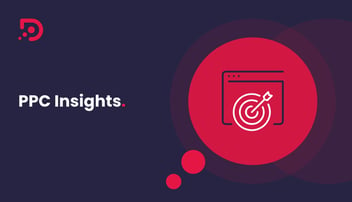As we’ve seen in some of our other PPC blog posts, PPC is complex. There are lots of moving parts and many things to configure, with all making a potentially significant impact on campaign costs and overall performance.
For PPC marketers who want to get results and demonstrate solid ROI, PPC tracking becomes crucial. Learning the fundamentals and tracking the right metrics will give you detailed oversight on campaign performance, letting you make ongoing optimisations and maximise the achievement of business KPIs.
In this blog post, we’ll tell you everything you need to know about PPC tracking, including:
- Fundamentals of PPC Tracking
- Key Metrics to Monitor in PPC Tracking
- What is a Conversion in PPC?
- Click Tracking and User Journey Analysis
- Importance of Unified Tracking in a Multi-device Era
- Advanced Tracking: Using UTM Parameters
- Integrating PPC Data with Analytics Platforms
Fundamentals of PPC Tracking
In PPC campaigns, accurate tracking is essential. It is the factor that distinguishes effective campaigns that deliver results from ones that muddle on, and potentially end up hoovering up budgets with little or nothing to show.
Accurate tracking in PPC allows you to:
- Allocate budgets efficiently by showing which keyword terms, ads, and bidding strategies are performing well and demonstrating good ROI.
- Avoid wasted ad spend by showing you in real-time when an ad is not performing as expected, so you can make changes to the ad or allocate budget elsewhere.
- Maximise ROI by reviewing metrics and refining the configuration of campaigns accordingly.
Without effective PPC tracking in place, you’re left with guesswork based on a limited level of insight. And in such a data-heavy marketing channel, where there are plenty of metrics to track and incorporate into your decision-making processes, you’d be foolish not to use them.
Key Metrics to Monitor in PPC Tracking

Effective PPC tracking relies on an understanding of the metrics that are available to track, so let’s now take a look at these. Each invites different insights, and taken in combination you’ll be able to build a more detailed picture of how your campaigns are performing.
Quality Score
As we explored in our post about how Google Ads work, Quality Score is a diagnostic tool provided by Google which ranks your ads from 1-10 to indicate the overall relevance of your ads to users.
Why it’s useful? This is a top-level metric to give insight into how well-positioned your ads are to perform well.
Ad Position
Ad position is fairly self-explanatory: it tells you which position your ad is showing in on the SERPs.
Why it’s useful? Understanding where your ad shows gives important context for other metrics.
Impressions
This refers to the number of times your ad was seen in a specified time period. Impressions do not include any active engagement by the user.
Why it’s useful? High impressions with low engagement can be a telltale sign that your ad is not optimised or targeted well.
Impression Share
Because PPC ads work on a bid system, there are times when your ad will be eligible for display but a too-low bid prevents it. Impression share shows the ratio between actual impressions and eligible impressions.
Why it’s useful? If your impression share is low, it may be a sign that your bid strategy is sub-optimal.
Click-through Rate (CTR)
This is the ratio of times your ad was clicked vs. not. CTR is a key engagement metric, and we highly recommend tracking this in any PPC campaign.
Why it’s useful? A good CTR means your ad is relevant and engaging users, as they are enticed by the ad copy to click through to the next step.
Cost Per Conversion (CPC)
This metric shows the average price you’re paying per conversion on your campaigns, giving good insight into ongoing budget allocation.
Why it’s useful? Comparing CPC to a customer’s spend is one of the cornerstone metrics for determining whether or not a PPC campaign is driving profit.
Cost Per Lead (CPL)
In a B2B context, you may be more interested in tracking Cost Per Lead rather than Cost Per Click, as this allows for longer sales cycles and a potentially longer journey to the overall desired outcome.
Why it’s useful? This may provide a means of tracking performance that aligns better with the B2B sales cycle.
Cost Per Mille (CPM)
In campaigns where brand visibility is an important consideration, you may want to track the average cost per 1,000 views or CPM.
Why it’s useful? CPM lets you understand the costs associated with brand visibility.
Conversion Rate
Taken with CTR and CPC, Conversion Rate is another fundamental PPC metric. This shows the ratio of users who are converting after clicking on your ad, i.e., achieving a commercially desirable outcome.
Why it’s useful? The purpose of PPC campaigns is to achieve conversions, making this metric indispensable. A low conversion rate suggests low relevance or low engagement with your audience, signalling that something needs to change.
Customer Lifetime Value (CLV)
This shows the average lifetime value of a customer acquired through PPC and takes into account repeat engagement.
Why it’s useful? CLV helps to conceptualise campaign ROI and advise future budget allocation.
Return on Ad Spend (ROAS)
Any PPC campaign needs to drive profit to be effective, and ROAS shows whether or not this is the case.
Why it’s useful? ROAS lets you understand whether your campaigns are profitable and whether budgets are allocated effectively and is crucial for ongoing decision-making.
What is a Conversion in PPC?
![]()
In the context of PPC, a conversion is a specific desired action a user can take when engaging with an ad. Conversions can vary depending on the customer’s position in the sales cycle, and some examples of B2B PPC conversions include:
- Requesting a free trial of software to see whether it addresses their needs
- Filling in a lead-capture form to access an ebook
- Booking a discovery call to find out more about a product or service
- Booking a demo to see a piece of software in action
- Signing up for a seminar where they can learn more about a concept
As you can see, there are many types of conversion besides making a purchase. The action that will appeal most to each user depends on their search intent, their overall needs, their position in the sales cycle and myriad other factors.
Choosing the right CTA for your PPC landing page is important in maximising the likelihood of a conversion. Offering a user who’s at the beginning of the research phase to ‘Buy now!’ probably won’t resonate; nor will offering an informational ebook to a user who is ready to make a purchase.
You can read more about choosing the right CTA in our PPC landing page guide.
Setting Up Conversion Tracking
To track desired conversions, you need to set up conversion tracking. Because this is a technical process that is subject to change as platforms evolve, we’ll link you to Google’s instructional resources for guidance:
- Setting up Google Ads conversion tracking: This is suitable for on-page conversions like form submissions, button clicks, and so on.
- Tracking mobile app conversions: If your PPC campaign involves ad-related conversion options, use this guide.
- Tracking phone calls from ads: If a potential conversion pathway is picking up the phone, this guide will help you track phone calls.
- More guides: For more nuanced conversion routes, Google offers these additional guides.
Click Tracking and User Journey Analysis
While conversions are the crux of a PPC campaign, there are more nuanced ways to analyse campaign performance. Digging deeper into what a customer does between clicking your ad and converting (or leaving!) gives more information you can use for analysis and review.
Click Tracking
As well as the obvious clicks, click tracking looks at how users arrive at each click. Did they hover over your link for a while, for example?
These insights provide a more detailed understanding of a user’s behaviour and can lead to more granular insights. However, be aware that they may add complexity to your campaign configuration and analysis.
Here are some things to consider:
- Hover tracking: How long users hover over CTAs before clicking, which can imply information about how engaging your CTAs are. Read here to learn how to set this up in Tag Manager.
- Heatmaps: Seeing a visual representation of how users move around your page can reveal pain points and opportunities for design improvements that might facilitate a better conversion rate. Hotjar is one example of heatmap software.
If you’re seeing user hesitation or signs that users are struggling to find what they need in your PPC campaigns, check out our guide to PPC landing pages to strengthen your content.
Understanding Paths to Conversion
A lot can happen between a click and a conversion, and knowing what happens can help you to identify and remove any potential roadblocks.
A very clear example would be a broken form on a PPC landing page: for as long as this error escapes your attention, conversion will not be possible and engagement metrics will plummet. But there are more subtle issues to identify.
- If you’re seeing good CTR but low Conversion Rate, take a look at your landing page to see whether there are obvious barriers to engagement: CTAs not showing, UX issues and so on. You can use Google’s Mobile-Friendly Test to ensure landing pages work properly on mobile.
- If there are no obvious issues, set up A/B testing to compare alternative page layouts and CTA configurations.
- Follow Google’s instructions to evaluate the performance of your landing pages to identify potential dropoff points.
Importance of Unified Tracking in a Multi-device Era

In an era defined by the use of multiple devices, coherent tracking takes on increased importance. Interactions from each device need to contribute to a unified tracking system so that advertisers have a clear and accurate source of data for review and analysis.
A PPC user journey is unlikely to be linear, either in a B2C or B2B context. There will be multiple devices and multiple campaign touchpoints, especially in complex buying cycles.
Measuring cross-device sessions is possible through Google Analytics, and is crucial in tying together touchpoints, sessions and interactions that would otherwise seem disparate.
Here are the required steps to access these reports in Google Analytics (note that these steps may change as the rollout from UA to GA4 continues):
- Set up the User ID
- Create a User ID view
- Access the Cross Device reports in the Audience section of your GA dashboard
Advanced Tracking: Using UTM Parameters
A powerful and often-overlooked tool for advanced tracking is the use of URL parameters for custom campaign tracking. With Google’s Campaign URL Builder tool, you can add the following parameters, each of which can be used for granular tracking within Google Analytics:
- Utm_source: the website, advertiser or other source sending traffic
- Utm_medium: the medium that is directing traffic, i.e. a banner, button, email or newsletter
- Utm_campaign: the internal campaign with which traffic is associated
- Utm_term: the paid keyword attributed with the URL, great for tracking the performance of specific PPC landing page
- Utm_content: a way to tag different variations of the same content, i.e. CTA buttons or similar
These parameters can be used in combination and not all are compulsory, giving you a sophisticated way to track and parse engagement.
Integrating PPC Data with Analytics Platforms
Linking your PPC data with analytics platforms unlocks deeper insight and allows for more advanced analysis by giving access to more detailed metrics, visible through bespoke reporting dashboards.
Deeper Insight
By linking ecommerce and CRM platforms with PPC analytics platforms, you can combine datasets and expand the level of insight available from campaigns. For example:
- Incorporating repeat purchases, subscriptions and other commercial outcomes makes it possible to calculate CLV and draw deeper conclusions about campaign ROAS over a longer time period.
- Segmenting users based on their behaviour lets you refine PPC campaign performance by demographic and incorporate these insights into future decision-making.
Custom Dashboards
Each PPC campaign is different, and the KPIs you’ll measure success against vary accordingly. To this end, bespoke reporting solutions are recommended.
In GA4 it’s easy to create custom dashboards that display only the metrics you’re interested in. Equipped with such dashboards, you can review campaigns on a real-time basis and make changes when issues arise.
You can learn more about creating custom GA4 reporting dashboards here.
In Conclusion
Tracking performance is a cornerstone of an effective PPC campaign. Without tracking, your efforts are left up to chance, and there’s a real risk of spending a lot of money on ads that don’t work.
Thankfully there are myriad PPC metrics that can be used in combination to reveal detailed insights on campaign performance.
Depending on your campaign goals and company objectives, the exact set of metrics you use will vary: In this post we’ve looked at choosing the right metrics, supplementing these with other tools like click tracking and advanced parameters, and setting yourself up for effective review and reporting.
Still looking for more information about PPC Services? We’ve got you covered. Find out more through one of the article below:
- B2B PPC: What is it & Why is it Important?
- PPC Management: How to Optimise Your Ad Campaigns
- PPC Strategy: A Comprehensive Guide
- PPC Keyword Research: A Comprehensive Guide
- PPC Ad Copy: A Comprehensive Guide
- PPC Landing Pages: A Comprehensive Guide
- PPC Analysis & Reporting: A Comprehensive Guide
- Why PPC Training Makes Sense for Marketing Managers
- How to Structure your PPC Campaign for Success
Or, why not check out our Definitive Guide to PPC Services.





